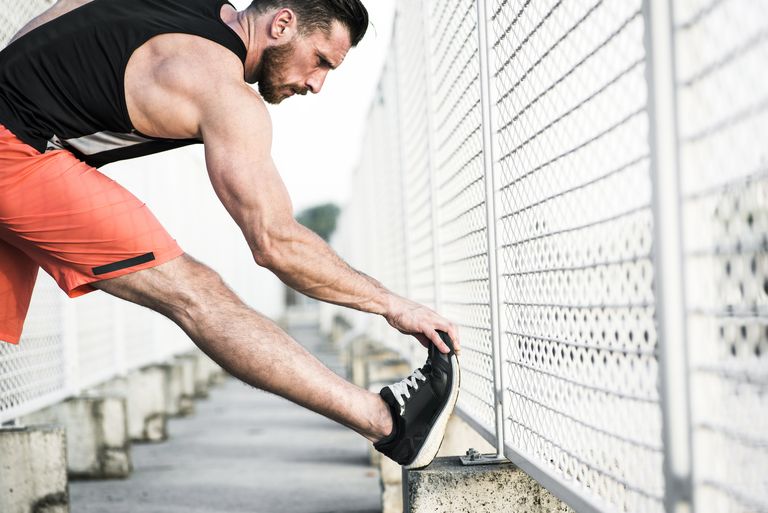As the grips of winter (hopefully) lessens in the next few weeks across the country, people will be eager to shake off their cabin fever and get outside to get active.
But it might not be the wisest decision to go straight out the door to your first long run workout after a long layoff. Depending on your state of health and fitness, your exercise program should begin with a discussion of your goals and desires with your medical doctor. Once you feel ready and confident to hit the road, beginners should have a plan of action to avoid overdoing it (check in with a reputable trainer, coach, or find a solid beginner's plan from a resource like MH to make one).

After you've kicked off the rust, started your training program, and begin logging miles, you might find yourself running more and more. This is when you might face a new problem: overuse injuries.
All injuries can be related to intrinsic factors and extrinsic factors. Intrinsic factors include genetic conditions, medications, and nutrition. Typically, most chronic injuries—what we're really focused on here—are directly related to extrinsic factors. These include overuse, training errors, poor shoe gear or equipment, poor biomechanics, and equinus condition.
How You Might Be at Risk of Injury
Let's break down these separate risk factors for runners. Biomechanics is the area specialty that studies human locomotion and efficiency—in other words, how you move and how well you do it. The average person will walk between 5,000 to 10,000 steps a day and approximately apply four times their body weight with every step. When running, the average person takes approximately 1,500 steps to travel just one mile, and they place eight times their bodyweight doing so. It is not unusual for someone to place several million pounds of pressure on their feet, lower extremity, and body in one day. That type of loading makes it paramount that a person is properly prepared to minimize the effects of faulty biomechanics.
The Achilles tendon is the largest and strongest tendon in the body. Ninety percent of people who live in Western society have a tight Achilles tendon due to wearing shoes; this condition is called Achilles Equinus. When the leg is perfectly straight, the foot should be able to dorsiflex (move inward toward the leg) 10 degrees past a right angle (90 degrees). When the Achilles tendon does not have the flexibility, this deformity is a major link into faulty biomechanics and overcompensation which can cause soft tissue injuries like lower back pain, iliotibial band syndrome, patella tendonitis, Achilles tendinitis, posterior tibial tendinitis, peroneal tendonitis, plantar fasciitis, and mortons neuroma’s, to name a few. Furthermore, pathomechanics (or changes to the normal biomechanical function of the joint) can lead to stress fractures, hammertoe deformities, bunion deformities, and even arthritis of the lower extremity joints. That's a long list of issues for what might seem like a small problem.
How does a tight Achilles tendon impact running biomechanics? As the foot is a very complex structure with over 26 bones, 33 joints, and over 100 ligaments and tendons, it will find ways to adapt to compensate for the tight Achilles tendon. The most common way for the foot “to trick” the Achilles into getting more range of motion is by overcompensating, flattening out, and lowering the arch. This is called over-pronation and the hindfoot midfoot joints will unlock and become more unstable. As running continues, the Achilles tendon absorbs more stress.
The constant stress, torque, and strain will eventually cause degeneration of the Achilles tendon and chronic thickening and swelling will develop. This condition is called chronic Achilles tendonosis. As the body will protect the Achilles tendon, weight will shift and other lower extremity structures will overcompensate and eventually break down. Over a long period of time, the soft tissue structures can degenerate and adaptations of the joints can eventually cause arthritis.
How to Prevent Overuse Injuries
So how can eager runners prevent this from happening? Emphasize your lower body in your warmup routines. Honing flexibility throughout the body is important, but really emphasizing range of motion and stretching of the Achilles tendon can be essential to prevent overuse injury in your lower extremities.
Work to mitigate Achilles problems by including static stretching, like hanging your heels down on a step or performing the wall stretch. Using a night splint or sock can also be very effective. Dynamic stretching with an exercise band works not only on flexibility, but also dynamic strength. Massage therapy, physical therapy, and chiropractic therapy are all modalities that can keep an athlete healthy too, if you're able to add those appointments to your schedule.
Lastly (and most simply), make sure that you have the appropriate type of running shoe. That doesn't just mean you pick out the best-looking shoe in the store, or exactly what your most seasoned running buddy wears. You should make sure you pick out a specific shoe to fit your foot type and body type.
A podiatrist, orthopedist, physical therapist, and chiropractor can help determine in conjunction with your local running store what products and shoes could be beneficial to prevent injuries. Many running-focused stores—most particularly small independent store—have employees who possess a wealth of knowledge to help you get going and are often plugged into the local running community. They're a solid place to find advice on potential running events, activities or educational opportunities in the area.
Depending on your condition after being properly fitted for a running shoe, there may be times that a heel lift, over-the-counter insole or custom foot orthosis can further improve faulty biomechanics and help with Achilles function. Many times local independent running shops have tremendous relationships with a local medical community to help the patient an athlete achieve health, fitness and performance. That way, you can get yourself in better shape to run longer.
The post How Runners Can Avoid Overuse Injury appeared first on Men's Health.
